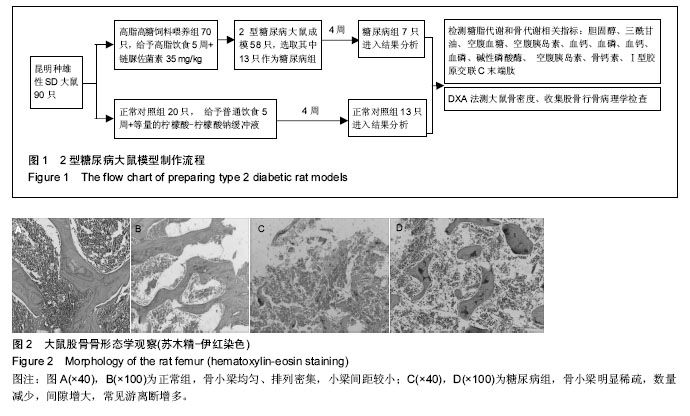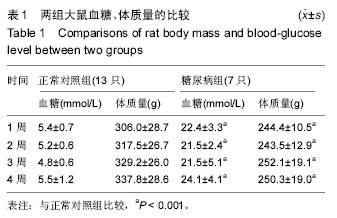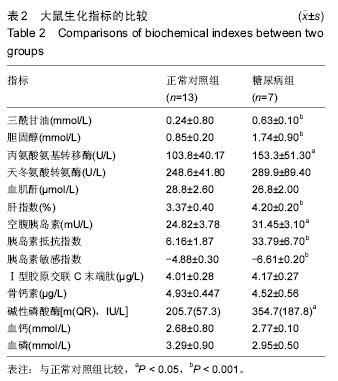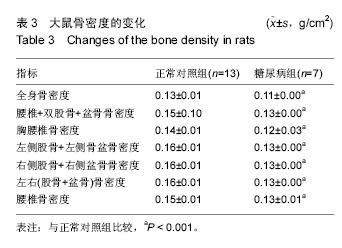| [1] Whiting DR, Guariguata L, Weil C, et al. IDF diabetes atlas: global estimates of the prevalence of diabetes for 2011 and 2030. Diabetes Res Clin Pract. 2011; 94(3):311-321.
[2] 孙权,姜广建,张文生.骨质疏松症治疗药物的研究进展[J].中国综合临床,2014,30(13):103-105.
[3] 高照华.内分泌代谢疾病相关性骨质疏松的研究进展[J].中国实验诊断,2013,17(3):590-593.
[4] Abdulameer SA, Sulaiman SA, Hassali MA, et al. Osteoporosis and type 2 diabetes mellitus:what do we know, and what we can do? Patient Prefer Adherence. 2012;6:435-448.
[5] Montagnani A,Gonnelli S.Antidiabetic therapy effects on bone metabolism and fracture risk. Diabetes Obes Metab.2013;15(9):784-791.
[6] Ceccarelli E, Guarino EG, Merlotti D, et al. Beyond glycemic control in diabetes mellitus: effects of incretin-based therapies on bone metabolism.Front Endocrinol (Lausanne) .2013;18(4):73-85.
[7] Abd El Dayem SM, El-Shehaby AM, Abd El Gafar A, et al. Bone density, body composition, and markers of bone remodeling in type 1 diabetic patients.Scand J Clin Lab Invest. 2011;71(5):387-393.
[8] Prisby RD,Swift JM,Franke S,et al. Altered bone mass, geometry and mechanical properties during the development and progression of type 2 diabetes in the zucker diabetic fatty rat. J Endocrinol. 2008;199(3): 379-388.
[9] Vestergaard P. Discrepancies in bone mineral density and fracture risk in patients with type 1 and type 2 diabetes--a meta-analysis.Osteoporos Int.2007;18(4): 427-444.
[10] Suzuki K, Ishida H, Takeshita N,et al.Circulating levels of tartrate-resistant acid phosphatase in rat models of non-insulin-dependent diabetes mellitus. J Diabetes Complications. 1998;12(3):176-180.
[11] Takeshita N, Ishida H, Yamamoto T, et al. Circulating levels and bone contents of bone gamma-carboxyglutamicacid-containing protein in rat models of non-insulin-dependent diabetes mellitus. Acta Endocrinol (Copenh). 1993;128(1):69-73.
[12] Guo Z, Zhang R, Li J,et al.Effect of telmisartan on the expression of adiponectin receptors and nicotinamide adenine dinucleotide phosphate oxidase in the heart and aorta in type 2 diabetic rats. Cardiovasc Diabetol. 2012;11:94.
[13] 李光伟,潘孝仁,Lillioja S,等.检测人群胰岛素敏感性的一项新指数[J].中华内科学杂志,1993,32(10): 656-660.
[14] 沈继平,何晓烨,胡予.高能高脂与限能高脂饮食对大鼠糖脂代谢及胰腺β细胞的影响[J].复旦学报:医学版,2013, 40(3):339-344.
[15] Gilbert ER, Fu Z, Liu D. Development of a nongenetic mouse model of type 2 diabetes. Exp Diabetes Res. 2011,2011:416254
[16] Huang BW, Chiang MT, Yao HT, et al. the effect of high-fat and high-fructose diets on glucose tolerance and plasma lipid and leptin levels in rats.Diabetes Obes Metab. 2004;6(2):120-126.
[17] Bowe JE, Franklin ZJ, Hauge-Evans AC, et al. Metabolic phenotyping guidelines: assessing glucose homeostasis in rodent models. J Endocrinol. 2014; 222(3):13-25.
[18] Berlanga A, Guiu-Jurado E, Porras JA, et al. Molecular pathways in non-alcoholicfattyl iver disease.Clin Exp Gastroenterol.2014;7:221-239.
[19] Hamann C, Goettsch C, Mettelsiefen J, et al. delayed bone regeneration and low bonemass in a rat model of insulin-resistant type 2 diabetes mellitus is due to impaired osteob last function.Am J Physiol Endocrinol Metab. 2011;301(6):E1220-1228.
[20] 王燕,李宝新,刘岩,等.2型糖尿病骨质疏松大鼠骨重建研究[J].基础医学与临床,2011,7(31):778-782.
[21] 张萌萌.骨重建中的骨代谢指标[J].中国骨质疏松杂,2013, 19(8):866-873.
[22] 张丽萍,荣海钦,季虹,等. 2 型糖尿病大鼠骨代谢和骨生物力学的观察[J].中国骨质疏松杂志,2008,5(14): 318-323.
[23] Cosman F, Combination therapy for osteoporosis: a reappraisal. Bonekey Rep.2014;3:518-526.
[24] 王亮,马远征,曾晓,等. 2型糖尿病大鼠模型建立及骨密度特点研究[J].中国骨质疏松杂志,2010,5(16):331-333.
[25] Espallargues M,Sampietro-Colom L,Estrada MD, et al. Identifying bone-mass-related risk factors for fracture to guide bone densitome try measurements: a systematic review of the literature.Osteoporos Int. 2001:12(10):811-822.
[26] Barrera G, Bunout D, Gattás V,et al.A high body mass index protects against femoral neck osteoporosis in healthy elderly subjects.Nutrition.2004;20(9):769-771.
[27] Gower BA, Casazza K.Divergent effets of obesity on bone health.Journal of clinical densitometry.2013;16(4): 450-454. |
.jpg)




.jpg)